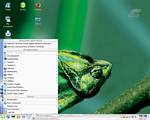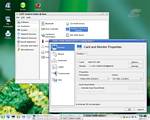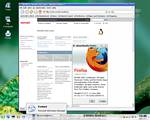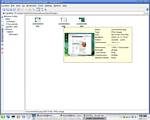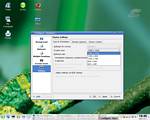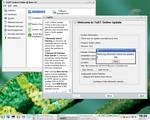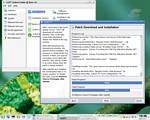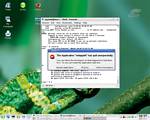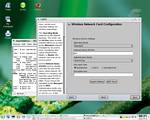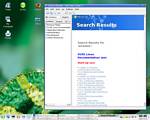Getting places with Suse Linux OSS 10 ?
By Niall C. Brady, October 2005.updated 16, January 2006 - added 'using bluetooth'.
Introduction
Installation
Updating software
Getting wireless to work...
Using bluetooth
Using Suse
Intel 800/900 series graphics chipsets
Conclusion
Screenshots
Introduction
After my last Suse Linux Professional experience I was looking forward to trying out the next major release since 9.3 hit the shelves. Interestingly Novell is now very kindly offering Suse Linux 10 for free (OSS) from the following mirrors on opensuse.org, so if you have access to broadband you can quickly download the 5 CD's and test Suse Linux OSS 10 yourself. Be aware that by giving it to you for free, that you won't get any support from Novell, but hey, if you are geeky enough to install Suse Linux, then support really shouldn't be an issue to you.If you do however require support, and like hands on documentation, then pull out your wallet and purchase a boxed set from Novell, that would surely make them happy :), in addition, you'll get extended support for different pc hardware architectures so for some that may be the only route to take (X86 64-bit systems). In addition to the support added to the retail version, you'll get a lot of extra packages included if you buy the retail box.
Back to top ^^
Installation
The Suse Linux OSS 10 installation was a walk in the park provided that you went with most of the defaults offered. I can see some 'linux noobs' having issues with the install if they tried to configure additional things such as adding extra packages or changing default resolution and refresh rate. To give you an idea of what I mean, during the hardware configuration of my installation, i tried to choose 'next' as often as possible, and by doing so, failed to configure my on-board network card (it was detected, but not configured), which as you can guess, meant no internet until i sorted it out using network tools after my first login. This to me is a minor point, but worth mentioning, as most users with an onboard network card would use them via DHCP (like me). So for me to have to manually 'tell' yast that my network card needed to use DHCP, seemed a little odd.Just as with my review of Suse Linux Professional 9.3, I decided to put a fairly new (and current) notebook computer to the test sporting the Intel 915GM chipsetwith Intel onboard video and an Intel wireless 2200bg card, broadcom gigabit NIC and some other standard components. The installation on this hardware went without so much as a hiccup (if you don't mind inserting the cd's that is). The Linux kernel shipping with Suse Linux OSS 10 is version 2.6.13-15-default and the version of xorg is X Window System Version 6.8.2 which is exactly the same version as shipped with Suse Linux Professional 9.3 back in April 2005.
Back to top ^^
Updating software
Updating your newly installed distro is always a good thing (necessary too, if you are in any way security conscious), so I clicked on my shiney new KDE 3.4 menu and eventually found what I was looking for in 'system/Control Center (YaST)'. Perhaps I am too picky, but for users who are migrating away from Microsoft Windows, it would be nice to see 'online update' on the KDE menu right at the top. Anyway, on with the show. Once you select the YaST Control Center and enter your root password (most administrative tasks in Linux require root privaledges) you have a number of choices. I wanted to do an online update so I clicked on 'Online Update'. After a few hard disc churning seconds, i was presented with a reasonably straightforward (but not so linux-noob friendly) screen for updating, i clicked on 'next' as that seemed to be the right thing to do. Up popped a window saying 'retrieving information about new updates' which sat at 0% for what felt like a long long time. So, I clicked on 'Abort' and decided to try a different mirror to the one that Suse had picked as default. Once I had it configured for a local mirror, it was very responsive and showed me a list of updates available. I clicked on 'Accept' and off it went updating Firefox amongst other things from version 1.06 to 1.07.To install updated or additional software or just to get information about what you have installed using the same tool (YaST) you can simply click on the drop down 'filter' menu which lists YOU (YaST Online Update) patches (that was the one I just did above), package groups, search and installation summary. I did this specifically to see if the Multimedia Packages that Suse 9.3 had, were listed, and they were not (as far as I could see) so xmms had to wait a while longer for MP3 support (alternatively, if you want xmms to play MP3's right now, get over to xmms.org and download and compile it yourself.)
To install programs from the command line you can very easily do as follows:-
yast --install xchat
which in the case above will install xchat from CD2. (I know, because I tried it).
Back to top ^^
Getting Wireless to Work
I had some wireless problems with Suse Linux Professional 9.3, so when I had the chance to test OSS 10, I was really hoping things would be better. What I now realise is not only are they not better, but in afterthought (maybe my own fault) they are worse. (For those that are wondering I am aware of the ipw2200 firmware, infact i'm happily using same on Fedora core release 4 with Intel 22000bg and no wireless issues at all). Trying to get wireless to work with the onboard Intel card was a pain in the butt. If you read through the installation above, you'll see i encountered a 'minor' issue whereby the internal network card was detected during the install, but because i clicked next instead of highlighting the card and configuring it, I ended up with no internet.That, I can live with, but the wireless fun really got me going. The wireless card WAS detected (just as the broadcom NIC was) during the install, but it appears that the all seeing YaST cannot determine if your NIC is Wireless or not once you've done what I did (which was to accept the defaults and click next). The result of this was that I spent a while (ok, a long while) looking for some 'wireless configurator' utility in the KDE menu and no, no no it was no where to be found.
Going into YaST again, (try 'yast2 lan' as root) i was indeed presented with ethernet cards, and it even listed my Intel Wireless card, however, clicking on it just allowed me to decide whether it was DHCP or not, and what routing I would like. Absolutely no mention of 'wireless access points, WEP or anything like that'. This got me a little bit frustrated so i clicked on the Suse Help Center icon. It wanted to index everything so I let it. After much crunching of the hard disc (yawn....) I finally got my chance and typed in my chosen word 'wireless'. I didn't see anything like 'how to setup wireless in Suse Linux' sadly, and that's where I left the help center.
Remembering my earlier experience with ETH0 being dead due to 'next, next' syndrome, I decided to delete the Intel wireless card in YaST. Finally, after doing that and reconfiguring it (adding it again...) I was greeted with 'real wireless options' such as 'access point name' etc. I think this must be a bug in YaST that need's to be addressed and I hope that my criticism of this will be looked on by those who are developing this software, to add 'safety points' to their wizards so that others don't feel my pain. One example of this was that YaST reset my WEP settings which I input, to some 'default' settings, which of course stopped me from connecting to my access points (both of which use WEP).
After some hours messing around with wireless and (wait for it) issuing commands in the terminal to determine the wireless 'state' of my notebook (try this as root, cat /sys/bus/pci/drivers/ipw2200/0000\:03\:03.0/rf_kill ) I decided enough was enough, and plugged my ethernet cable back in. Boom, ifup eth0 and i have working internet again. To cut a long story short, I did get wireless to work once during my testing, and I have no real idea how. All those multiple ifup ifdown eth1 coupled with 'yast2 lan' and it's menu system left me in no doubt that wireless and Suse is still a sore point (as it was with Suse Linux Professional 9.3). I really, really hope that Suse Linux OSS 11 fixes this.
Let me give you one final example of what I mean about Suse and wireless, in the YaST Control Center, you have a 'bluetooth' icon. That's great. But where is the Wireless icon which the Operating System clearly can see ?
Back to top ^^
Using Bluetooth
Configuring bluetooth in Suse was a reasonably pleasant surprise, the bluetooth module I tested was the built in Dell Bluetooth 350 (as shipped on Latitude D610/D410/D810 and Precision Workstation M70). Once I enabled bluetooth in the bios and booted suse, KDE detected the module and asked me did I want to configure it. I answered yes, typed in my root password and tried to get things working. One of the things it asked me for was the bluetooth security pairing code and I entered it.Next I turned on bluetooth on my mobile phone (a Sony-Ericsson K600i) and watched in amazement as apparently nothing happened. Oh well, at least there was a bluetooth icon in my systray. To cut a long story short I did get file transfer of mp3's from my phone to the laptop and it worked great, however it took three attempts to get it to work, the reason for that was because it once again prompted for the bluetooth security pairing code however, the prompting window was BEHIND the current (and live) bluetooth window I had open, so of course I didn't see it and bluetooth communication failed for me (or so i thought). Once I had identified this window and input the code, all went well and bluetooth worked very nicely indeed.
Back to top ^^
Using Suse
The KDE desktop is very nice I must admit, and it is through Suse Linux that KDE is actually growing on me (I use gnome mostly). I like the way when you hover over a picture a large thumbnail of it appears along with info about the picture itself. I also like the reasonably clutter free desktop with only a few icons there by default.The graphical boot up and graphical login screen is also very nicely done, and during the boot up phase you can always press ESC to see the usual kernel messages. Boot time is quite snappy for a linux distro, even resuming from suspend to disk happens at a good speed. For the purpose of this review (which I wrote in vi for anyone who is interested), I plugged in a standard USB key to copy the screenshots over for quick transfer to another pc, and KDE popped up a YaST hardware notification telling me it had found new hardware. Cool, easy and simple, no need to find the 'usb key' icon on the desktop, nicely done.
Next I inserted a blank CDR into the cd burner and sure enough YaST popped up asking what to do with it, I decided to use k3b and put it to the test. Absolutely no problems with it, burned the files just fine. While waiting a few minutes for the cd to burn, i opened up my newly updated Firefox and put in the following url which is an MP3 tune I composed years ago (1995 or so...). As with Suse Linux Professional 9.3, RealPlayer took over and played the MP3. Good stuff, but I still can't for the life of me understand why RealPlay does it and xmms can't (as shipped). Pointing xmms at the same URL produces nada. Not even 'due to licensing issues we don't play MP3's sorry'. Oh well. No big deal.
Next up I tested shockwave and Java in Firefox, and both performed just fine. It's very very nice to see a distro (and OSS one too) shipping with these plugins pre-installed (hint to other distro vendors !!) and I really commend Suse for making linux noobs life that little bit easier. Ok, so I can burn cd's, mount my USB key and listen to MP3's with realplayer while surfing on shockwave and java enabled sites, but what else ? Well, the beauty of linux is that there is just so much you can do, host a webserver with apache, do office tasks in OpenOffice 2.0pre, chat on the internet with xchat and Gaim for instant messaging, it's all there in Suse, and that's no surprise as it's also all there in just about every other distro I've tried.
What makes Suse stand out from the crowd is the 'feel' of things. The desktop 'feels' professional and when you do stuff, it just works and works very well too with minimal effort (except wireless ;-)). I would like if YaST was 'easier' to use, and came with something that looked and functioned like a Windows device manager, but I guess that is asking too much. Sure it can list your devices but just try doing something with them (did I mention wireless ?).
Power Management for me, was another issue in the past release of Suse Linux (9.3). When I tried a suspend to disk back in April, it gave me a pretty slick kernel oops every time I suspended to disk, which as you can imagine didn't go down very well. So before I tried the same with Suse Linux 10 OSS, I saved my current documents, but left everything I had open (xchat/gaim/firefox/4 terminals/konqueror/k3b/xmms/realplayer). I needn't have bothered as to my delight suspend to disk worked perfectly first time, second time, third time, fourth time. Well done Suse on fixing that !
Back to top ^^
Intel 800/900 series graphics chipsets.
As I already experienced before with Suse Linux Professional 9.3, newer Intel graphics chipsets (for example 915GM) may have issues with setting resolution correctly, sadly this has not been fixed in Suse Linux OSS 10 and you'll have to manually get/install the following program 915 resolution.The end result of this is if you have a 1400x1050 LCD on your notebook (and I do) then you will not see the resolution correctly no matter what you tell YaST or SaX2. During my installation of Suse Linux OSS 10, I manually configured X and told it I wanted 1400x1050 resolution, but it completely ignored what I asked for and decided 1280x1024 was more appropriate. By installing the above mentioned program, you'll get the expected result. The lack of an applied workaround available (with the shipping cds) for users with Intel 915 graphics chipsets may be enough to keep users at bay. I'm curious as to why Suse didn't do anything (that I can see) about this issue, seeing as it was also present in 9.3.
Back to top ^^
Conclusion
I am very happy that Suse Linux OSS 10 is freely downloadable for all to try it out, and the vast majority of Suse users will most likely love this release. However, notebook users (particularly new Intel chipset based notebooks) expecting a good wireless experience may like me, get very frustrated and that is an area that Novell/OpenSuse/Intel must focus on before the next major release.Power management has definetly improved most likely due to the newer kernel. The overall look and feel is very similar to Suse Linux Professional 9.3, with a slightly changed YaST installer, and new color coding throughout. My overall feeling about Suse Linux OSS 10, is a mixed bag of emotions. I'm very happy that Power Management has improved but at the same time I'm disappointed with the wireless support (centrino 2200bg) and i'm also disappointed with the incorrect video resolution. If like me you have issues with wireless in Suse, make sure to verify if you have the ipw2200 firmware from Intel applied.
However, that said, Suse Linux OSS 10 is well worth a look, and I'm sure Suse will continue to dominate the linux distro world. This release, gets a 7/10 from me. The three marks I took away, are directly related to the wireless support (-2) and video resolution problems (-1). Better luck next time Suse, I really want to give you a 10/10.
Back to top ^^
Screenshots
The following screenshots show exactly what you'll see when you install Suse from beginning to end so if you are new to Suse then look at how nicely the installation is doneor... have a look at the screenshots below (post install, high quality PNG screenshots so do expect the image loading to be slow).
| |||
| |||
| |||
| |||
|
Back to top ^^ (c) http://www.linux-noob.com 2005. Created by anyweb on October 19th, 2005 |
